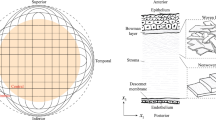Purpose: To increase the stability of the cornea by artificial cross-linking (radiation or chemical agents) and to investigate a future therapy for keratoconus.
Materials and methods: The epithelium of enucleated porcine eyes was removed. Ten eyes in each of eight test groups were treated with UV light (λ = 254 nm), 0.5 % riboflavin and UV light (365 nm), blue light (436 nm) and sunlight, and the chemical agents glutaraldehyde (1 % and 0.1 %, 10 min) and Karnovsky's solution (0.1 %, 10 min). Strips of 5 mm in width and 9 mm in length were cut from each cornea and the stress-strain behaviour of the strips was measured. For comparison, eight groups of ten untreated corneas each were measured by the same method.
Results: Compared to untreated corneas riboflavin and UV irradiation as well as glutaraldehyde and Karnovsky's solution treatment resulted in significantly increased stiffness of the cornea (p < 0.05).
Conclusions: The biomechanical behaviour of the cornea can be altered by low-concentration glutaraldehyde, Karnovsky's solution, and by riboflavin and UV irradiation, which offers potential conservative treatment of keratoconus. To optimize this effect further investigation is necessary regarding the dose-effect relation and the in-vivo conditions.
Hintergrund: Die biomechanische Festigkeit der Hornhaut soll durch künstliche Quervernetzung der Kollagenfibrillen (Strahlenvernetzung, chemische Vernetzung) erhöht werden, um eine evtl. konservative Therapie des Keratokonus zu prüfen.
Methode: Von enukleierten Schweineaugen wurde das Epithel entfernt. Je 10 Augen in 8 Testgruppen wurden mit UV-Strahlung (λ = 254 nm), einer 0,5 %igen Riboflavinlösung und UV-Strahlung (365 nm), blauem Licht (436 nm) und Sonnenlicht sowie mit chemischen Vernetzern – Glutaraldehyd (1 % und 0,1 %, 10 min) und Karnovsky- Lösung (0,1 %, 10 min) – behandelt. Als Standard dienten jeweils Kontrollgruppen mit 10 unbehandelten Hornhäuten. Aus jeder Hornhaut wurde ein zentraler Streifen von 5 mm Breite und 9 mm Länge geschnitten und die Spannungs-Dehnungs-Kurven gemessen.
Ergebnisse: Bei UV-Bestrahlung von mit Riboflavin vorbehandelten Hornhäuten nimmt die Dehnbarkeit signifikant ab (p < 0,05). Auch die mit Glutaraldehyd oder Karnovsky-Lösung behandelten Hornhäute zeigen eine signifikante Zunahme der Festigkeit (p < 0,05).
Schlußfolgerung: UV-Strahlen und Riboflavin sowie niedrigkonzentriertes Glutaraldehyd oder Karnovsky-Lösung führen zu einer Verfestigung der Hornhaut wahrscheinlich aufgrund von Vernetzungen der Kollagene oder der Proteoglykane. Weitere Untersuchungen sind jedoch bezüglich der Optimierung der Dosis-Wirkungs-Beziehung und der In-vivo-Bedingungen erforderlich.
Similar content being viewed by others
Author information
Authors and Affiliations
Rights and permissions
About this article
Cite this article
Spörl, E., Huhle, M., Kasper, M. et al. Artificial stiffening of the cornea by induction of intrastromal cross-links. Ophthalmologe 94, 902–906 (1997). https://doi.org/10.1007/s003470050219
Issue Date:
DOI: https://doi.org/10.1007/s003470050219




